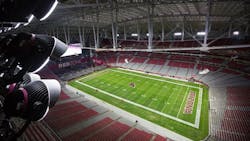Cree LEDs Light Super Bowl for First Time
LED lighting manufacturer Cree Inc., Durham, N.C., will be center stage at the Super Bowl this weekend. The game between the Seattle Seahawks and the New England Patriots will be played under Cree LEDs used in fixtures by Ephesus Lighting.
Following a complete LED retrofit on the University of Phoenix Stadium where the Super Bowl will be played, its lighting now uses just 310,000 watts of energy as compared to the 1.24 million watts needed to power the previous system: a 75 percent reduction in overall sports lighting energy consumption.
“With LEDs not previously viable for full stadium lighting, beyond energy savings and a better light experience, this signifies that 100 percent LED adoption is within our reach; and Cree has driven the technology to be viable for every general lighting application,” said a Cree release.
312 Ephesus Lighting stadium fixtures featuring 44,928 Cree XLamp MK-R LEDs were installed in the University of Phoenix Stadium to replace more than 780 metal halide fixtures. Each Ephesus LED light provides nearly double the illumination of traditional metal halide lights.
“The capabilities of LED technology have changed the way we view sports lighting,” Joe Casper, founder and chief technology officer of Ephesus Lighting, said in the release. “This was a great opportunity to showcase our innovative lighting technology in a venue known as a leader in introducing new ideas to the sports marketplace.”
The switch to LED also saves time. Most stadiums rely on high-intensity gas discharge fixtures for the main lighting that take time to power up to full brightness—a half hour is common. LED lights, in addition to being efficient, can be turned on and off with the flick of a switch as LEDs have more control and metal halide fixtures typically require a minimum 20-minute warm-up period.
LED lights provide brighter and more uniform light, which eliminates shadows on the playing surface and creates a better stage for players, fans, and those watching on high-definition televisions. The lighting also helps with the slow-motion camera and replays.
